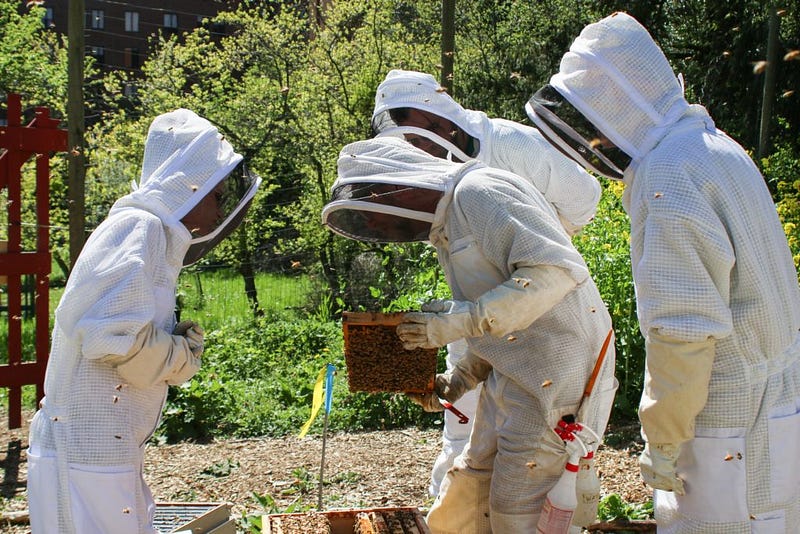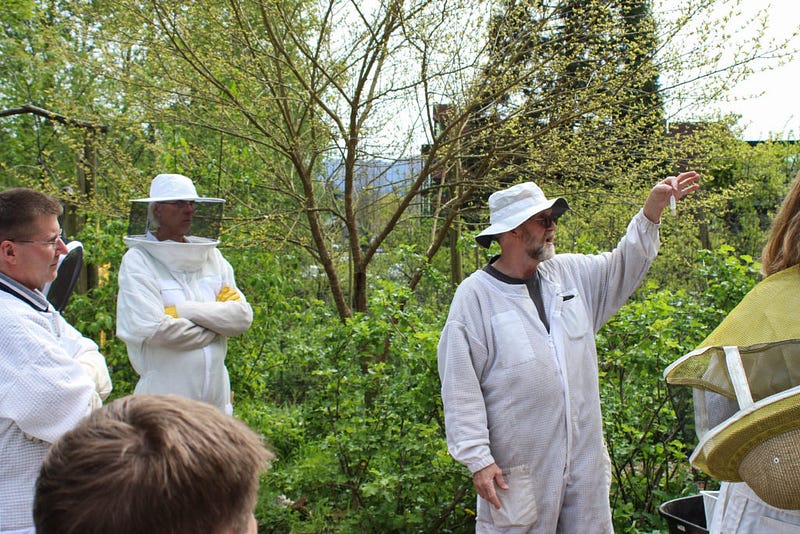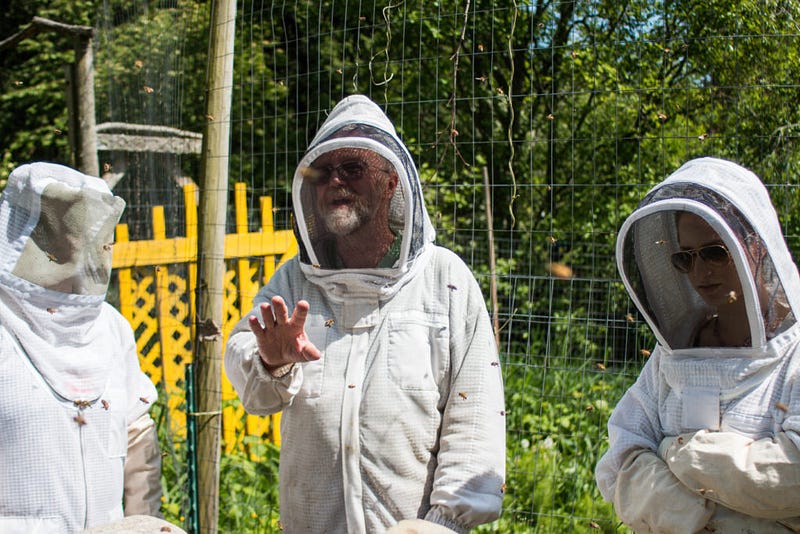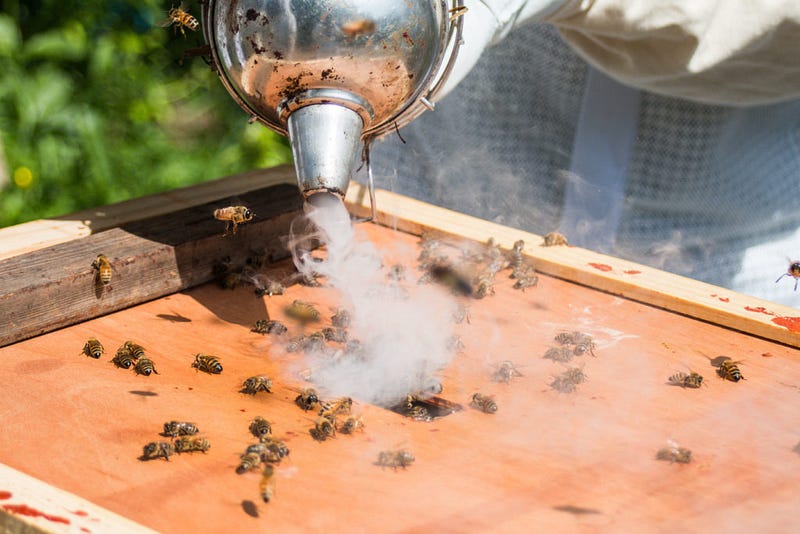Keeping the buzz alive
Beekeeping is no longer about honey, but the interdependence between humans, honeybees and survival
STORY AND PHOTOS BY KYRA BRUCE
Hundreds of honeybees flow like water into a clear, wide-mouthed canning jar. They are mixed with a dollop of powdered sugar and sealed off with a screen.
Rolling the jar in his hands, tumbling the bees, a man with a well-kept graying beard and glasses peaks through a mask of white mesh. Firmly, but gently, he shakes the jar upside-down, letting sugar rain on a plastic board. When he’s finished, he spritzes it with water.
In his baggy suit, hunched over a board coated in wet, powdered sugar, 12-season beekeeping veteran Michael Jaross counts tiny, reddish-brown dots interspersed in the semi-opaque mixture. This powdered sugar roll gives Jaross an almost-lab-quality estimate of the number of minuscule, Dungeness crab-looking mites living in a hive.
It is commonly said that a third of everything that shows up on your table is due to pollination by honeybees. Bees and humans depend on one another to stay alive. For beekeepers, the beaming warmth and budding flowers, brings the buzz of life back to the hives, but it also comes with life and death challenges that demand a close eye on honeybees. It is about controlling mite populations and preventing colony loss through swarming in an effort to maintain honeybees’ health and keep them alive through the season.
Spring Time
The warmth of the early afternoon sun beats down on stacks of brightly colored boxes nestled in the back of the Outback Farm in Bellingham, Washington. There, tens of thousands of honeybees are emerging from their hives. Resting atop their hives and basking in the sun, these tiny, unassuming insects warm their bodies and prepare their muscles for flight.
They are not the fat, aggressive, yellow and black insects that come to mind when you think of a bee. They are Apis mellifera carnica — Carniolan honeybees. Their slim, muted-brown bodies are armored and fuzzy. Their abdomen is striped with light and dark, dusty brown. Their wings are delicate and strong.
In the heat of late spring, when the honeybee population is at its pique and they have confidence in their resources, the bees will work for the entirety of their six-to-eight-week lives. Workers, brood, resources and a queen will leave the hive in an attempt to relocate and reproduce. Carniolan honeybees in particular are prone to swarming, but this is the first time in Pacific Northwest history that honeybees have swarmed as early as March.
“A few of our hives are in swarm control,” Jaross says.
Two stacked boxes containing a queen and worker honeybees sit with a thick “queen divider” screen resting on top. The hive has been separated and divided to prevent the colony from swarming. The top portion contains workers and most of the brood, but lacks the all-important queen who is confined to the bottom box.

The honeybees’ instincts tell them to swarm. They live to provide for the next generation of the hive, but if they swarm, they will not survive long on their own at the hands of the Varroa Destructor Mite. If left untreated, this uninvited guest will kill a colony in one to two years.
For Jaross, an ideal count of Varroa Mites in a hive would be 10 or fewer. His most recent powdered sugar roll revealed a count of 40 to 50 mites at best and over 100 at worst.
“It was the Mite Apocalypse!” Jaross says. He had never seen such high mite populations this early in the year. Usually, it is with the heat of late summer, after the honey season, that Varroa Mite populations soar.
“But that’s climate change for you,” Jaross says with a half joking smile.

The Varroa Destructor
In the last 30 years, new parasites and pathogens have been introduced to honeybee populations around the world due to the boom of global trade. Rapid movement of goods around the world moved diseases and parasites the to U.S. where honeybees lacked any sort of immunity.
The Varroa Mite migrated from Asia and appeared in Europe in the 1980s before it found its way to Whatcom County in 1987.
When a honeybee queen lays her eggs in a hive’s honeycomb, worker bees will provide the larvae with food before capping off the cell and leaving the baby honeybees to mature. But, the female Varroa Mite can dart inside and lay her own eggs just before the cell is sealed.
There, in the honeycomb cell, the mites reproduce incestuously, living off the larvae and pupa’s hemolymph — the equivalent of blood in insects. When the matured bee finally chews its way out of the cell, the new Varroa Mites burst forth and the vicious cycle of devastation continues and grows.
Continuous exposure to the mites leads to Varroosis, a widespread contraction of viruses that will ultimately kill an entire colony. Varroa mites infect the honeybees with different viruses as they feed on them and puncture their exoskeletons. Most, if not all of the time, bees do not have any resistance to these viruses and have little hope of surviving in the wild without the help of beekeepers.
“Many people just quit beekeeping because it was almost impossible to keep bees alive,” Jaross says.

Constant Maintenance
A thin, 5-inch strip of plastic is wedged between two sticky, wooden frames that are coated in hexagon upon hexagon of yellow-brown wax. The strip dangles in the depths of the hive from a single toothpick resting on the frames.
Busy worker bees go about their daily chores, moving in and out of the hive along the frames. The honeybees work, paying no mind to the intrusive strip of plastic hanging in their home. They appear as one fluid layer of brown, fuzz and wings on the surface of the frame.
Little do they know, this strip of plastic, coated in a miticide called Amitraz will sit in the hive for 42 days, slowly killing the intrusive Varroa Mite.
“A lot of beekeeping today, although beautiful, is working together with another completely alien species,” Jaross says. “Beekeeping actually becomes mite-keeping and mite control at one point.”
This is the first time Jaross has felt the need to use a chemical to combat mite populations in his hives. Unlike large-scale beekeepers, Jaross has the ability to keep in touch with his hives and constantly monitor their development. He visits the hives four to five times each week and treats and maintains the honeybees based on what each colony needs.
“It’s more disruptive, which leads to less [honey] production,” Jaross says, explaining how his hands-on methods compare to commercial beekeeping. “There is a limit to how much care commercial beekeepers can lavish on [their] livestock without going out of business.”
Jaross practices Integrated Pest Management (IPM), a method that requires him to open the beehives often, closely monitor them for mites and diseases and use the least powerful but effective treatment. It’s invasive. It’s time consuming. And after the appearance of the Varroa Mite, IPM became infinitely more labor-intensive.
“I am willing to sacrifice some honey production and perhaps bee production in order to have living colonies,” Jaross says. It is an easy compromise to make when his honeybees have a 90 to 100 percent survival rate each year compared to the 56 percent national average.

Turning Back Time
Jaross uses a metal tool to prod through the frames of a hive. He inserts the flat end of the tool between two frames and wiggles it to move any honeybees out of his way. Then he inches the frame away from the others, fighting the sticky brown propolis that glues each frame to the hive, sealing off any cracks and crevices.
This hive was divided and the honeybees were separated from their queen a few weeks earlier to prevent them from swarming. Now, the bees have had over three weeks to make a new queen and have all the resources of a small colony.
Jaross pulls frames out of the hive, one by one, in search of the new queen. Protective worker bees surround her on one of the inner frames. It is time to create a new colony.
A box filled with new frames sits on the ground. Jaross pulls frames out from the new box and replaces them with some of the honeycomb-coated frames from the old hive. These new frames will lay the foundation for honeycomb while the old frames move honey, brood and the scent of home to the new hive.
Jaross sets the honeybees’ timeline back to where they were in January as he divides the hive. The new colony will have time to build its population and resources in time to survive the winter, but will not have the excess resources to swarm as summer approaches.
As temperatures rise, Jaross will continue to visit his hives. “It’s hoped that honeybees will eventually evolve some means to coexist with mites. But, as you know, evolution can be painfully slow,” Jaross says.
Until then, Jaross will monitor Varroa Mite populations, divide and treat the hives as necessary to keep his bees happy and healthy.
